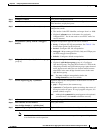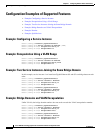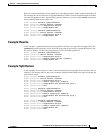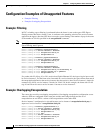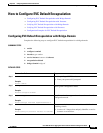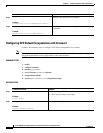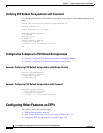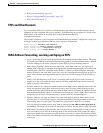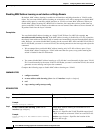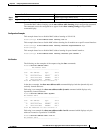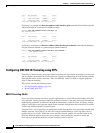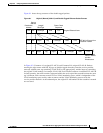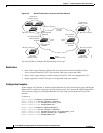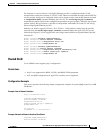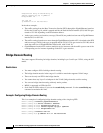
8-17
Cisco ASR 901 Series Aggregation Services Router Software Configuration Guide
OL-23826-09
Chapter 8 Configuring Ethernet Virtual Connections
Configuring Other Features on EFPs
• Bridge Domain Routing, page 8-24
• How to Configure DHCP Client on SVI, page 8-25
• EFPs and MSTP, page 8-27
EFPs and EtherChannels
You can configure EFP service instances on EtherChannel port channels, but EtherChannels are not
supported on ports configured with service instances. Load-balancing on port channels is based on the
MAC address or IP address of the traffic flow on the EtherChannel interface.
Configuration Example
This example configures a service instance on an EtherChannel port channel. Configuration on the ports
in the port channel are independent from the service instance configuration.
Router (config)# interface port-channel 4
Router (config-if)# service instance 2 ethernet
Router (config-if-srv)# encapsulation dot1q 20
Router (config-if-srv)# bridge-domain 2
MAC Address Forwarding, Learning and Aging on EFPs
• Layer 2 forwarding is based on the bridge domain ID and the destination MAC address. The frame
is forwarded to an EFP if the binding between the bridge domain, destination MAC address, and EFP
is known. Otherwise, the frame is flooded to all the EFPs or ports in the bridge domain.
• MAC address learning is based on bridge domain ID, source MAC addresses, and logical port
number. MAC addresses are managed per bridge domain when the incoming packet is examined and
matched against the EFPs configured on the interface. If there is no EFP configured, the bridge
domain ID equal to the outer-most VLAN tag is used as forwarding and learning look-up key. For
native VLAN frames, the bridge domain equal to the access VLAN configured in the interface is
used.
If there is no matching entry in the Layer 2 forwarding table for the ingress frame, the frame is
flooded to all the ports within the bridge domain. Flooding within the bridge domain occurs for
unknown unicast, and broadcast.
• Dynamic addresses are addresses learned from the source MAC address when the frame enters the
router. All unknown source MAC addresses are sent to the CPU along with ingress logical port
number and bridge domain ID for learning. Once the MAC address is learned, the subsequent frame
with the destination MAC address is forwarded to the learned port. When a MAC address moves to
a different port, the Layer 2 forwarding entry is updated with the corresponding port.
• Dynamic addresses are aged out if there is no frame from the host with the MAC address. If the
aged-out frame is received by the router, it is flooded to the EFPs in the bridge domain and the Layer
2 forwarding entry is created again. The default for aging dynamic addresses is 5 minutes.
You can configure dynamic address aging time by entering the mac address-table aging time [0 |
10-1000000]. The range is in seconds. An aging time of 0 means that the address aging is disabled.
• MAC address movement is detected when the host router moves from one port to another. If a host
moves to another port or EFP, the learning lookup for the installed entry fails because the ingress
logical port number does not match and a new learning cache entry is created. The detection of MAC
address movement is disabled for static MAC addresses where the forwarding behavior is configured
by the user.



